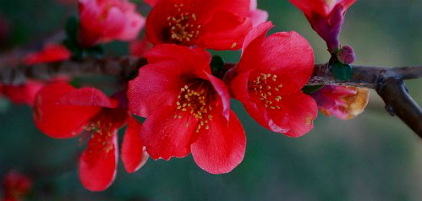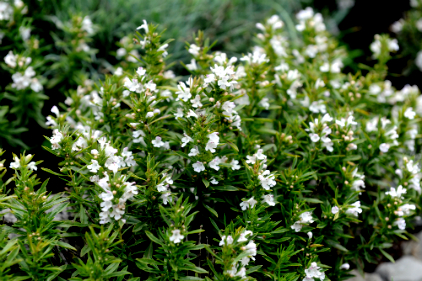 bringing nature, nurseries and gardeners together Feb 12, 2021
|
|
Winter strikes: it is mind-boggling to look at the low forecast for Monday: 1°F. This falls within a 6 day pattern of freezing and frosts. The Arctic has indeed come to Austin. This is a crucial time in the gardening calendar when our most vulnerable plants need protection to survive. Our friends at the Natural Gardener have provided some important tips on how to cover them up effectively.
1. Be sure that the covering reaches all the way to the ground so that it holds in heat from the earth. Rocks can be used to keep it in place.
2. Keep space between the plant and the covering so that it isn’t resting directly on the leaves. Plant stakes can be used to help lift it away.
3. Upside down cardboard boxes can be a convenient way to protect pots & plants. / If you plan on visiting a nursery over the next 5 days, call ahead or check websites to see if they are open or not. ❦

Flowering quince: despite the Arctic temps, with its pretty salmon/pink/orange flowers, Chaenomeles speciosa is popping up all over Austin declaring that spring is on its way. This tough beauty can handle drought, poor soil and urban pollution, and thrives in full sun to part shade. ❦
________________________________________________
Barton Springs Nursery: in a recent issue of 'Digging,' author Pam Penick interviewed Amy Hovis and William Glenn, proud new owners of this treasure of a garden center. "It’s still surreal and a dream come true to think that all that hard work and all those years culminated in this," muses William. Digging ❦
________________________________________________
Storybook beauty: garden design tips on focal points, repetition, visual balance and strong shapes from a quartet of US and UK landscape artists. Garden Design ❦
________________________________________________
Firefly magic: join expert Ben Pfeiffer on Tuesday at 7 p.m. for a meeting of the Native Plant Society of Texas. Ben will talk about the wonderous fireflies of Texas and the native plants important to them. On-line, open to all. N.P.S.O.T. ❦
 Help turn Hancock Golf Course into 50 acres of beautiful parkland in central Austin by signing this petition: Hancock Conservancy Poll. ❦ Help turn Hancock Golf Course into 50 acres of beautiful parkland in central Austin by signing this petition: Hancock Conservancy Poll. ❦
________________________________________________
Valentine's at the Wildflower Center: free DIY Valentine's card take-home kits will be given out to visitors from 10 a.m. to noon tomorrow (Saturday); ideal for pre-school and elementary school students. By reservation only. Wildflower Center ❦

Figments: "Late January and early February is tree trimming time," writes artist Linda Anderson. "Started my fig today and thought to make a sketch. Everything is so brown-ish in the garden these days. Beautiful in it's own way." ❦
________________________________________________
Central Texas Gardener: in the studio, an interview with Susan Morrison, author of "The Less is More Garden." On tour, a visit with Lori and Jack Shreved who put out the welcome mat for wildlife in their beautiful Georgetown garden; John offers tips on growing strawberries. KLRU ❦
 Winter Savory is a perennial herb that pairs well with beans, chicken and turkey.
February in the Garden
by Chris Winslow
1. Plant fruit trees. Peaches, pears, persimmons, plums, pomegranates… and apples and apricots too. These all do well in this area. For those with limited space, or with an appetite for novelty, try a ‘four-in-one’ grafted apple or pear. These have four different varieties grafted onto the same tree. If you don’t have a yard, try a dwarf peach… easily grown in a pot or whisky barrel.
2. Plant vegetables in kitchen garden. Asparagus crowns, broccoli, Brussels sprouts, cauliflower, cabbage, carrots, Swiss chard, pod peas (sugar snaps) and lettuce. Also onions, such as the white Texas supersweet called Contessa.
3. Plant winter-hardy herbs. Thyme, oregano, Italian and curled parsley, rosemary, winter savory (pictured above) and summer savory, garden sage, and chives. Herbs need at least a half a day’s sun in a well-drained location.
4. Plant flowers in the garden. Calendula, pansies, stock, cyclamen, violas, dianthus, bluebonnets, nasturtium, flowering cabbage and kale, and larkspur. For a great show, plant snapdragons now for April and May color.
5. Plant a rose. Besides some good old standbys like Peace, Mr. Lincoln, Climbing Don Juan and Blasé, there are some interesting newcomers to look for, such as the Knock Out series, Home Run and Belinda’s Dream. Let’s not forget our charming antique roses which are disease-resistant, hardy, and can shower our landscapes with the most beautiful, showy flowers.
6. Prune your roses. This is an activity for mid-month, typically around Valentine’s Day, which falls on Sunday this year. Please proceed with caution. Be sure to know what kind of rose you have. Most shrub roses bloom on new wood, so a pruning will help to force new growth and blooms. Climbing roses, however, bloom on old wood. If you prune them, you will remove all the flowers before they have a chance to bloom. If in doubt, please give me a call at the nursery for some advice.
7. Clean up the landscape. Cut back perennials and apply a mulch-compost blend. Add green sand and sulfur to plants that prefer their soil to be a little more acidic. Check leaves for signs of iron deficiency. Light green leaves with darker veins indicate a lack of iron that green sand and sulfur will help to cure.
8. Control lawn weeds. Spread a pre-emergent weed killer over the yard and water it in. We recommend corn gluten. This is an effective organic pre-emergent that will not poison waterways and aquifers. If you spread it over the lawn, it will control those spring and summer weeds before they have a chance to germinate. You can safely use it in the garden or in flowerbeds.
9. Maintain garden tools. Repair and clean garden tools. Change the oil on the lawnmower, and have the blades sharpened.
10. Garden plan for 2021. Put something down in a book, a diary, or even on a scrap of paper that you tape to the wall. The more modern gardener can even create some sort of a spreadsheet. This will help you plan your weekend activities through the year and get your plants in the ground at the correct time of the year. ❦
|
 It's About Thyme Legacy Publications.
Contact newsletter editor Darrel Mayers with any ideas for articles or interesting links at internationalrain@yahoo.com (hitting 'reply' to this email won't work) |
|
|